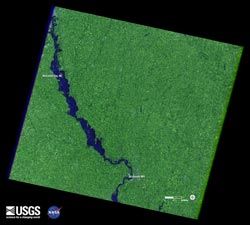Landsat Satellites Track Continued Missouri River Flooding

Flooding down the Missouri River continues along the Nebraska and Iowa border as shown in this Landsat 7 satellite image of July 17, 2011. Heavy rains and snowmelt have caused record flows. Green represents vegetation, dark blue is water. Credit: USGS/NASA <br>
A Landsat 5 image of the area from May 5, 2011 shows normal flow. In contrast, a Landsat 7 image from July 17 depicts flood conditions in the same location.
A national overview map of streamflow provided by U.S. Geological Survey (USGS) WaterWatch graphically portrays the immense geographic extent of flooding in the Missouri River basin.
Monitoring both floods and droughts, the USGS WaterWatch internet site displays maps, graphs, and tables that describe current and past streamflow conditions for the United States. The real-time streamflow data is generally updated on an hourly basis.
The Landsat Program is a series of Earth-observing satellite missions jointly managed by NASA and the U.S. Geological Survey. Landsat satellites have been consistently gathering data about our planet since 1972. They continue to improve and expand this unparalleled record of Earth’s changing landscapes, for the benefit of all. The next Landsat satellite is scheduled to launch in December 2012.
For the USGS WaterWatch website, please visit:
http://waterwatch.usgs.gov/new/index.php?id=ww
For more information about the Landsat launching in 2012: http://ldcm.gsfc.nasa.gov Jon Campbell, USGS,703-648-4180 joncampbell@usgs.gov
Rob Gutro, NASA's Goddard Space Flight Center, Robert.j.gutro@Nasa.gov
Media Contact
All latest news from the category: Earth Sciences
Earth Sciences (also referred to as Geosciences), which deals with basic issues surrounding our planet, plays a vital role in the area of energy and raw materials supply.
Earth Sciences comprises subjects such as geology, geography, geological informatics, paleontology, mineralogy, petrography, crystallography, geophysics, geodesy, glaciology, cartography, photogrammetry, meteorology and seismology, early-warning systems, earthquake research and polar research.
Newest articles

Properties of new materials for microchips
… can now be measured well. Reseachers of Delft University of Technology demonstrated measuring performance properties of ultrathin silicon membranes. Making ever smaller and more powerful chips requires new ultrathin…

Floating solar’s potential
… to support sustainable development by addressing climate, water, and energy goals holistically. A new study published this week in Nature Energy raises the potential for floating solar photovoltaics (FPV)…

Skyrmions move at record speeds
… a step towards the computing of the future. An international research team led by scientists from the CNRS1 has discovered that the magnetic nanobubbles2 known as skyrmions can be…




















